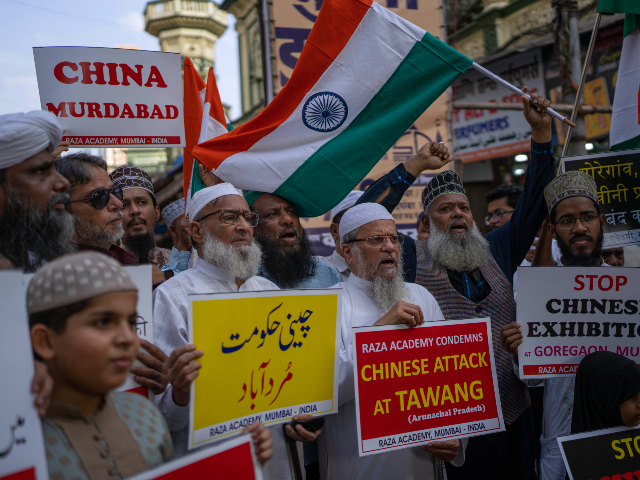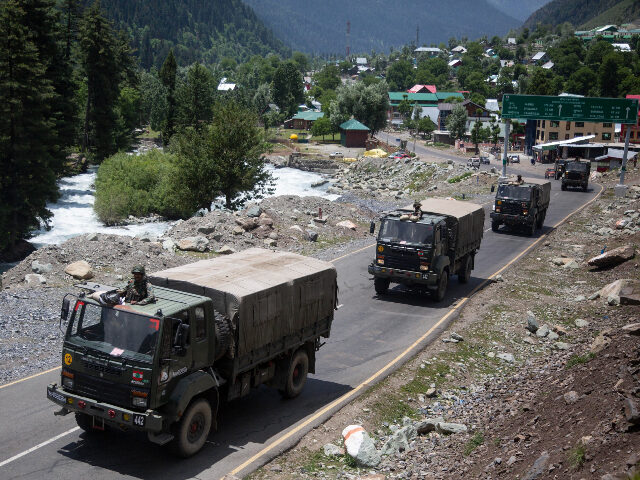The Indian Army announced in a statement on Monday that Chinese soldiers had invaded the country on their mutual border in the Himalayas, resulting in a violent clash that left, according to some reports, dozens of soldiers injured.
The Chinese Foreign Ministry refused to confirm or deny the incident on Tuesday, stating only that the situation on the countries’ mutual border was “normal” and demanding India respect longtime mutual agreements on where the border lies between them. Foreign Ministry spokesman Wang Wenbin did not deny, however, that any tensions had flared in the region or any of the specific reports on what happened this weekend.
If confirmed, the latest incident – reportedly occurring in India’s Arunachal Pradesh region – follows years of tensions that appeared, for now, to have climaxed in the gruesome 2020 Galwan Valley incident, in which dozens of Indian and Chinese soldiers died beating each other with sticks, clubs, and other rudimentary weapons.
Shortly following that incident, in September 2020, the Indian military seized a disputed mountaintop around Pangong Tso, a Tibetan lake, and changed its rules of engagement to allow soldiers to bear firearms on the Chinese border. The Chinese People’s Liberation Army (PLA) reportedly issued similar changes to its rules of engagement following the Galwan Valley incident.
In September 2020, both sides reported the first shots fired on the mutual border in 45 years.
The brawl in the Tawang area of Arunachal Pradesh reportedly occurred on Friday and did not involve firearms.
“On 9 December 2022, PLA troops crossed the LAC [Line of Actual Control, the formal name of the China-India border] in the Tawang sector, which was contested by own troops in a firm and resolute manner,” the Indian Army said in a statement on Monday. “This face-off led to minor injuries to a few personnel from both sides.”
Defense Minister Rajnath Singh updated the Indian Parliament on Tuesday, confirming that the incident did occur and emphasizing that no troops are known to have died.
While the Indian Army did not offer much more detail, multiple Indian media outlets, citing unnamed sources, claimed that between 200 and 600 Chinese soldiers invaded Arunachal Pradesh carrying rudimentary weapons and attacked the Indians. India’s The Print claimed that over 200 Chinese soldiers “armed with spiked clubs with nails on them, monkey fists and taser guns” attacked the Indians on their own land. Monkey fists, the publication explained, are “a crude weapon made of iron that is worn on the wrist.”
The outlet, citing unnamed “sources in the defense and security establishment,” said that the 200 Chinese soldiers fought, but could not overwhelm, 50 Indian soldiers, though the initial group of Indians later counted on a much larger contingent that arrived for backup.
“This clash, according to sources, started off with stone pelting before troops from both sides engaged in hand-to-hand combat,” the outlet claimed.
Other Indian outlets did not describe the brawling in any detail and differed on the number of Chinese troops involved. The news service ANI put the number of Chinese fighting at about 300 troops. The Hindu newspaper claimed over 600 Chinese soldiers had invaded India.

Indians hold placards as they shout slogans during a protest against China in Mumbai, India, Tuesday, Dec. 13, 2022. Soldiers from India and China clashed last week along their disputed border, India’s defense minister said Tuesday, in the latest violence along the contested frontier since June 2020, when troops from both countries engaged in a deadly brawl. (AP Photo/Rafiq Maqbool)
The Chinese Communist Party has offered little information on the incident, but has not openly refuted India’s claims. During his regular press briefing on Tuesday, Foreign Ministry spokesman Wang Wenbin told reporters that the Chinese-Indian border is “generally stable,” without confirming if the brawl happened.
“We hope that the Indian side will meet China halfway, implement the important consensus reached by the leaders of the two countries, strictly abide by the spirit of the relevant agreements signed by the two sides, and jointly maintain peace and tranquility in the border region,” the Chinese regime publication Global Times summarized Wang as saying.
A spokesman from the People’s Liberation Army’s (PLA’s) Western Theatre Command, the military office responsible for the Indian border, did confirm the altercation, but claimed the Indian soldiers had crossed into China “illegally,” the South China Morning Post reported.
“Our troops’ response is professional, firm and standard, which has helped to stabilise the situation,” the spokesman, Long Shaohua, reportedly said. “Both sides have been under disengagement since then.”
China and India have not experienced any major deadly battles on their border since the Galwan Valley incident, which occurred in June 2020. That incident, according to Indian sources, resulted in the deaths of about 20 Indian troops and double that number of Chinese soldiers. The low-tech nature of the melee, fought with sticks wrapped in barbed wire and similar weapons, meant that many died by falling off steep cliffs or of hypothermia.
The Chinese government only confirmed four deaths in the Galwan Valley incident.
A potential Himalayas clash in December, as opposed to the milder summer months, could result in more injuries if fought in similar terrain to that of the Galwan Valley. Tawang is about 1,000 miles southeast of Ladakh, where the Galwan Valley is located, on the opposite end of Tibet. The Indian military has for months, however, warned that China was unilaterally increasing tensions along the border and making more clashes likely.
“We have agreements with China going back to the 1990s which prohibits bringing mass troops in the border area. They have disregarded that,” Indian External Affairs Minister Subrahmanyam Jaishankar said in August. “You know what happened in the Galwan Valley. That problem has not been resolved and that has been clearly casting a shadow.”
“They are our neighbors. Everybody wants to get along with their neighbor. In personal life and country-wise as well,” Jaishankar continued, “But everybody wants to get along with on reasonable terms. I must respect you. You must respect me.”

COMMENTS
Please let us know if you're having issues with commenting.